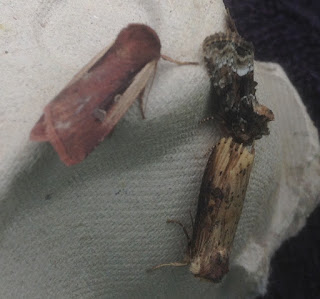The 'longhorn' family of micromoths always raise a smile from me or even a chortle which may occasionally have perplexed early morning dogwalkers on the path beside our house. There are a dozen or more species in which the males are given the benefit of these vast antennae, which are three or more times as long as the moth's body. Invaluable for detecting females and leading to mating - the over-riding purpose of all moths' lives - they must be a burden, especially in flight. Yet the males of several longhorn species are known for their 'dancing' manouevres which can involve a whole group, often in sunlight. The moths' equivalent of Strictly and suchlike TV contests.

It can be hard to distinguish between species, especially with my lack of photographic skill, but I think from the little mark on the folded forewing that this is Nematapogon metaxella. Other curiosities of the tribe include the way that some of their caterpillars eat on decaying leaf matter from which they then construct their chrysalises.
The yellow part of the colour spectrum often provides relief from the browns and greys of many moths, though I always try to leaven such criticism with approving comments about the intricate patterns and very subtle differences in shade which distinguish all but the plainest species. No such efforts are required with the Barred Yellow, my second moth, a cheerful enthusiast for dog roses of which we have many locally in bloom.
Yet again, with my mind on yellow, I bring you the Scorched Wing whose camouflage famously delights me. It has been more abundant this year than ever before, and Hooray for that.
 |
| This is one of the less apparently-blurred pics I've taken of a Scorched Wing, maybe because the black and white pattern of the accompanying Small Magpie micro (dozens of these about at the moment) helps the eyes to adjust. |

White is another lightener of the greys and browns and June, July and August bring plenty of such relief. Here is a lovely, if slightly worn, Miller which was perching on the bulb-holder, undisturbed by our predatory robins and blackbirds. It has the brown, moth equivalent of a 'Prince Charles' bald patch but that is a minor defect. Like the famous Peppered Moth, Millers can vary from very white, like this one, to assorted greys which in some parts of the North verge almost on dark. The 'dusty' appearance gave rise to the species' name.


A moth which combines yellow and white is around at the moment, the Yellow-tail. On initial inspection, you might be puzzled at the name but if you goad a male sufficiently, up will pop his tail between the wings with its striking - and no doubt to predators, alarming, blob of golden-yellow at the end. I am sorry that the lurid colours of my pyjamas coupled with the difficulty of getting my iPad Mini into position to take a picture, have caused blurring. But if you look carefully, you can just see a bit of the said yellow peeping out to the right of the smudge on the white wings. I will keep trying for a better shot.
Finally, here is a very attractive and very small macro moth, the Small Fan-footed Wave, which you may occasionally set up from foliage on a field walk, when it flutters away like a wind-blown flower petal. Like the longhorn mentioned above, its caterpillars prefer withered foliage to fresh. There's no accounting for taste.


























































